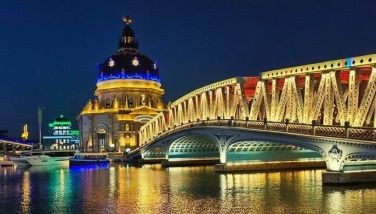I dig the etruscans!
September 19, 2004 | 12:00am
Six days into our week-long stay in Tuscany, my wife and I and two friends, both Florentine residents, decided to break away from the Renaissance museum that is Florence and go deep into Italy’s pre-Roman past – its Etruscan past.
I was first introduced to the Etruscans when I spent two months in Italy in 1973. In an attempt to do something completely different from business school, I decided to learn Italian and take a film course in Rome. Unfortunately upon arriving at the school, I learned to my chagrin that the film course had been cancelled. The alternatives were painting and archaeology. The latter meant digging all summer whilst the former meant just that – painting. The choice was easy; I was going to be the next Picasso. So I embarked on an odyssey of trying to paint movement, capturing the baroque spirit of Rome through color, and so on and so forth. I burned all my paintings at the end of the course (they were truly execrable) but I did have one brush with archaeology and the Etruscans which left a lingering impression on me. Towards the end of my stay, I visited friends who had opted to take the archaeology course in Cerveteri.
Cerveteri, which is just outside of Rome, boasts a large Etruscan necropolis (cemetery) which at the time was not fully excavated. As is true in most digs, the archaeologists always opted to recruit slave labor in order to cut costs. Slave labor meant getting students who were willing not only to work for free, but to actually pay for the privilege of hacking away in a dig all summer. So not only did the archaeologists save on labor; they actually made some money off it! Anyway, I distinctly remember that the day I visited Cerveteri was the day Bruce Lee died (the news was all over Italian radio). My friends took me to the dig and, once there, I decided it would be foolish to leave without actually crawling into a partially excavated tomb and peeping into the main burial area. A peephole is normally carved out so that archaeologists can peer into an unopened tomb without disturbing anything. What I saw through the peephole was some broken pottery, bones scattered on the floor, and a partially ruined fresco. The consequence of this momentary encounter was a lifelong curiosity about the Etruscans and the land called Etruria.
Etruria lay in central Italy between the valley of the Tiber, the valley of the Arno, and the Apennines. Legend has it that the Etruscans originated from Lydia, kingdom of the legendary King Midas, he of the golden touch. They were a nation of navigators, traders, and industrial producers, "driven to actions of immediate practicality." They left behind many tombs and settlements and some written records. Unfortunately the Etruscan body of writing is distinctive in its paucity of information on the culture whence it sprung. This has rendered the Etruscans as something of a mystery as no one really knows what they were all about. Suffice it to say that they were not strong enough to become a major player in the Mediterranean world and, as a result, became an historical footnote.
There are traces of the Etruscans all over Tuscany – in Lucca, Pisa, Fiesole, Florence, Arezzo, Siena. Today, at the insistence of an English expatriate who was going with us on this tour, we were going to two other Etruscan sites – Murlo and Volterra.
The main point of interest in Murlo is an ongoing excavation of an Etruscan agricultural center and the museum which houses all the artifacts found therein. The museum itself is small and well put together but slightly humdrum. The most interesting part of the exhibit is a reconstruction of the roof of a building excavated in the area. Atop the roof sits an Etruscan cowboy, a terracotta figure with a wide brimmed hat on his head. The rest of the artifacts on display were some funerary urns, everyday utensils, some gold jewelry and other items of daily life. After an hour of browsing we were all quite hungry, so we decided to eat in the one and only restaurant in town. Surprise, surprise – we had a great meal in the middle of nowhere. Then it was off to Volterra.
Volterra, like many Etruscan cities, sits atop a plateau with uninterrupted views of the surrounding hills. It boasts the Pinacoteca e Museo Civico art gallery with works by Ghirlandaio, Signorelli, and Fiorentino; the Duomo; the Museo d’Arte Sacra; the Teatro Romano; and the Arco Etrusco. The main attraction, however, is the Museo Guarnacci. It contains one of the best collections of Etruscan artifacts in Italy, gathered from numerous local tombs. Amongst a plethora of artifacts, there are 600 funerary urns offering unique insight into Etruscan customs and beliefs. One such urn is called the "Married Couple." Atop the urn sits an elderly couple realistically portrayed, with haggard, careworn faces. Another room contains the elongated bronze known as the Ombra della sera or "Shadow of the Evening." This name was bestowed by the poet Gabriele d’Annunzio, who said the bronze reminded him of "the shadow thrown by a human figure in the dying light of the evening". It may be a votive figure but it is difficult to say with certainty; it was cast with no clothes or jewellery to indicate rank, status or date. It is only by chance that this remarkable figure has survived. It was ploughed by a farmer in 1879 and used as a fire poker until someone recognized it as a masterpiece of Etruscan art.
Despite all the bits and pieces of the Etruscans that are strewn about Italy, the fact is they were a weak culture and retreated when stronger civilizations came along. The result of this retreat in the face of Greek cultural superiority and relentless Roman expansionism was an almost complete obliteration of their culture.
"The Etruscan world remained extraneous to the rational order of classical thought. In its last phases, beginning in the 4th century BCE, the Etruscan nation withdrew into itself in its archaism and its provincialism, dominated above all by the elaboration of a complex religious thought and by the minuteness of its rites, which made it proverbially famous in the ancient world. When Greece had reached the peak of the inimitable creativity of classicism, declining Etruria remained behind, bogged down in its traditions, impoverished in technique."
My curiosity about the Etruscans more than satisfied, we left Volterra tired and dispirited even though the day was far from over and the sun was still high up in the sky. I think we were all suffering from "funerary urn fatigue." Six hundred of them in one sitting is almost too much for one human being to take; after all they were used to contain dead bodies. But my spirits lifted when, from the corner of my eye, I saw a poster advertising (in script which leapt out of the page) an exhibit of torture and its many hideous instruments. Now there’s something I can really sink my teeth into!
I was first introduced to the Etruscans when I spent two months in Italy in 1973. In an attempt to do something completely different from business school, I decided to learn Italian and take a film course in Rome. Unfortunately upon arriving at the school, I learned to my chagrin that the film course had been cancelled. The alternatives were painting and archaeology. The latter meant digging all summer whilst the former meant just that – painting. The choice was easy; I was going to be the next Picasso. So I embarked on an odyssey of trying to paint movement, capturing the baroque spirit of Rome through color, and so on and so forth. I burned all my paintings at the end of the course (they were truly execrable) but I did have one brush with archaeology and the Etruscans which left a lingering impression on me. Towards the end of my stay, I visited friends who had opted to take the archaeology course in Cerveteri.
Cerveteri, which is just outside of Rome, boasts a large Etruscan necropolis (cemetery) which at the time was not fully excavated. As is true in most digs, the archaeologists always opted to recruit slave labor in order to cut costs. Slave labor meant getting students who were willing not only to work for free, but to actually pay for the privilege of hacking away in a dig all summer. So not only did the archaeologists save on labor; they actually made some money off it! Anyway, I distinctly remember that the day I visited Cerveteri was the day Bruce Lee died (the news was all over Italian radio). My friends took me to the dig and, once there, I decided it would be foolish to leave without actually crawling into a partially excavated tomb and peeping into the main burial area. A peephole is normally carved out so that archaeologists can peer into an unopened tomb without disturbing anything. What I saw through the peephole was some broken pottery, bones scattered on the floor, and a partially ruined fresco. The consequence of this momentary encounter was a lifelong curiosity about the Etruscans and the land called Etruria.
Etruria lay in central Italy between the valley of the Tiber, the valley of the Arno, and the Apennines. Legend has it that the Etruscans originated from Lydia, kingdom of the legendary King Midas, he of the golden touch. They were a nation of navigators, traders, and industrial producers, "driven to actions of immediate practicality." They left behind many tombs and settlements and some written records. Unfortunately the Etruscan body of writing is distinctive in its paucity of information on the culture whence it sprung. This has rendered the Etruscans as something of a mystery as no one really knows what they were all about. Suffice it to say that they were not strong enough to become a major player in the Mediterranean world and, as a result, became an historical footnote.
There are traces of the Etruscans all over Tuscany – in Lucca, Pisa, Fiesole, Florence, Arezzo, Siena. Today, at the insistence of an English expatriate who was going with us on this tour, we were going to two other Etruscan sites – Murlo and Volterra.
The main point of interest in Murlo is an ongoing excavation of an Etruscan agricultural center and the museum which houses all the artifacts found therein. The museum itself is small and well put together but slightly humdrum. The most interesting part of the exhibit is a reconstruction of the roof of a building excavated in the area. Atop the roof sits an Etruscan cowboy, a terracotta figure with a wide brimmed hat on his head. The rest of the artifacts on display were some funerary urns, everyday utensils, some gold jewelry and other items of daily life. After an hour of browsing we were all quite hungry, so we decided to eat in the one and only restaurant in town. Surprise, surprise – we had a great meal in the middle of nowhere. Then it was off to Volterra.
Volterra, like many Etruscan cities, sits atop a plateau with uninterrupted views of the surrounding hills. It boasts the Pinacoteca e Museo Civico art gallery with works by Ghirlandaio, Signorelli, and Fiorentino; the Duomo; the Museo d’Arte Sacra; the Teatro Romano; and the Arco Etrusco. The main attraction, however, is the Museo Guarnacci. It contains one of the best collections of Etruscan artifacts in Italy, gathered from numerous local tombs. Amongst a plethora of artifacts, there are 600 funerary urns offering unique insight into Etruscan customs and beliefs. One such urn is called the "Married Couple." Atop the urn sits an elderly couple realistically portrayed, with haggard, careworn faces. Another room contains the elongated bronze known as the Ombra della sera or "Shadow of the Evening." This name was bestowed by the poet Gabriele d’Annunzio, who said the bronze reminded him of "the shadow thrown by a human figure in the dying light of the evening". It may be a votive figure but it is difficult to say with certainty; it was cast with no clothes or jewellery to indicate rank, status or date. It is only by chance that this remarkable figure has survived. It was ploughed by a farmer in 1879 and used as a fire poker until someone recognized it as a masterpiece of Etruscan art.
Despite all the bits and pieces of the Etruscans that are strewn about Italy, the fact is they were a weak culture and retreated when stronger civilizations came along. The result of this retreat in the face of Greek cultural superiority and relentless Roman expansionism was an almost complete obliteration of their culture.
"The Etruscan world remained extraneous to the rational order of classical thought. In its last phases, beginning in the 4th century BCE, the Etruscan nation withdrew into itself in its archaism and its provincialism, dominated above all by the elaboration of a complex religious thought and by the minuteness of its rites, which made it proverbially famous in the ancient world. When Greece had reached the peak of the inimitable creativity of classicism, declining Etruria remained behind, bogged down in its traditions, impoverished in technique."
My curiosity about the Etruscans more than satisfied, we left Volterra tired and dispirited even though the day was far from over and the sun was still high up in the sky. I think we were all suffering from "funerary urn fatigue." Six hundred of them in one sitting is almost too much for one human being to take; after all they were used to contain dead bodies. But my spirits lifted when, from the corner of my eye, I saw a poster advertising (in script which leapt out of the page) an exhibit of torture and its many hideous instruments. Now there’s something I can really sink my teeth into!
BrandSpace Articles
<
>



















